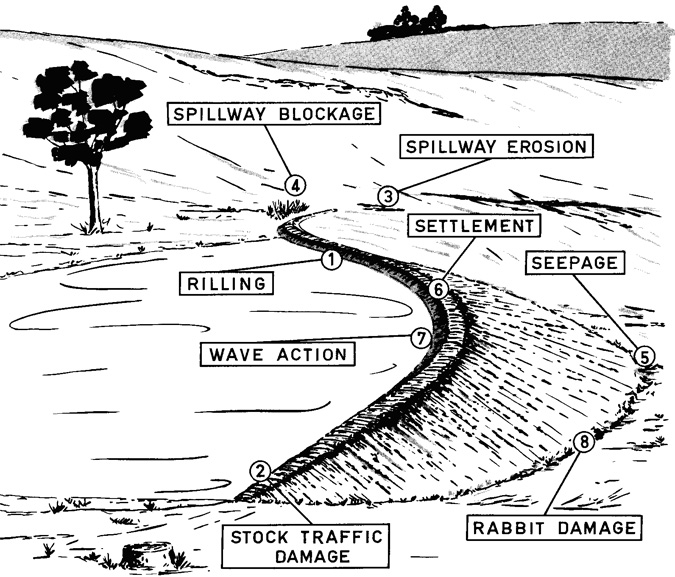Maintaining your farm dam
The dams on your property need to be regularly inspected and maintained to keep them in good order. If you neglect your dam, extensive repair work may be required.

Dam bank maintenance
Vegetative cover
A layer of topsoil over the bank (to a depth of 150mm minimum) is essential to keep a contiguous vegetative cover. Only low growing plants should be planted and allowed to remain on the bank. Larger plants are undesirable as they may drive roots into the core of the dam wall and both dry it out and open up potential routes for seepage.
Add topsoil to poorly covered or damaged areas. Seed or sod as appropriate.
Stock traffic damage
The bank is a relatively harsh environment for plant growth. Grazing stock will readily remove plant cover by grazing and trafficking. Further, they are likely to cause structural damage as they follow preferred routes.
Fencing-out of the dam (along with a reticulation system) should be considered. If this is not an option, short lengths of fence could be used to deflect stock.
Rilling
Pack pasture sods complete with soil into any rills.
Settlement
Even well compacted dams will settle a little. An allowance of 5% of bank height is common for farm dams. Poorly compacted dams will settle over 10%.
Check the amount of freeboard as the dam fills. Top-up where necessary (or alternatively lower spillway inlet). Cracks through the bank may indicate uneven settlement.
Slumping
Cracks along the length of the wall may point to future slumping. Primary cause is a combination of poor compaction, excessive seepage and excessive steepness of bank.
Seek professional advice.
Seepage
Wet spots in wall or at the toe of the bank indicate that water is moving through the bank. Check the upstream face. Encourage the pasture cover right to the water level. Dig-out and repack soil spots on the upstream face which may be inlet sites for a seepage into the bank.
Tunnelling
Seepage lines in tunnel prone materials will readily turn into tunnels or 'pipes'. As an interim measure these may be plugged with carefully compacted soil. Some people have used a bentonite — sand mix as the plug in a ratio as 1:2. Tunnels indicate that the bank integrity is poor and professional advice is desirable.
Rabbit damage
Remove rabbits.
Dig out burrows and repack with clay based material.
Maintain effective rabbit control.
Spillway maintenance
Vegetative cover
The spillway has to be capable of safely carrying flood flows of water from the full supply level of the dam back to the drainage line. A good vegetative cover along the spillway is essential for this. It needs to be actively growing, robust and relatively uniform.
Fertilise, reseed and trim as appropriate.
Do not let it become 'clumpy' or 'weedy'
Blockages
Keep the spillway clear of debri and tall grass.
Rilling
These will rapidly extend if they are allowed to start in the spillway. Repair immediately.
Trickle flows
If small flows consistently travel down the spillway in the winter or spring months, the vegetative cover on the spillway will be modified. Vegetative loss and soil erosion may well then occur when flood flows occur.
Consider the installation of a trickle flow pipe to intercept such flows and divert them down a PVC pipe. For further information on Trickle flow pipes for farm dams.
Maintaining the body of water
Wave action
Lay stone or establish runner grasses on the sides of the storage where damage is occurring. Consider the strategic location of trees and shrubs to intercept some of the energy of prevailing winds.
Turbidity
Turbidity is induced by erosion in the catchment or dispersive materials in the excavation.
Control sediment moving into the dam. Control stock access which may resuspend materials in the dam.
If clarified water is needed for domestic purposes, consider pumping water to a tank and flocculating the suspended material there.
Growth of algae
The accumulation of nutrients in farm dams can result in excessive algal growth in the summer and autumn months.
It is not easy to fix the problem once it occurs. It's best to deal with the causes as outlined in Minimising algal growth in farm dams.
Maintenance of a minimum level
Do not allow any earth dam to dry out. The integrity of the wall can be compromised and failure may well result at the next fill.
Catchment maintenance
Erosion
Erosion in the catchment can readily fill the dam with sediment rather than water — control it.
Nutrients
Nutrients from areas intensively used by stock or from excessive fertiliser (especially if near to a drainage line directly feeding the dam) can facilitate algal growth in dam.
Manage nutrient movement and use in the catchment. See Minimising algal growth in farm dams.
Inflow filter zone
Small quantities of sediment and nutrients in catchment flows can be intercepted and utilised by a heavily vegetated filter zone immediately upstream of the dam.
During dry seasons or after fires sediment traps can be built to minimise sediment, faeces and vegitation run into your dam. Watch the video Building a sediment fence on our managing dams page.